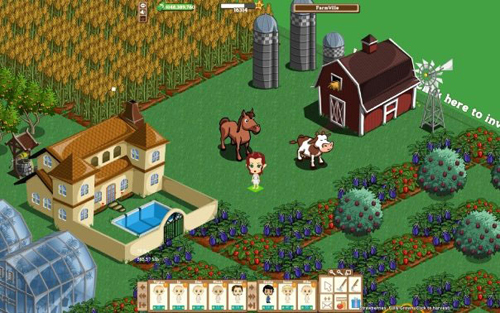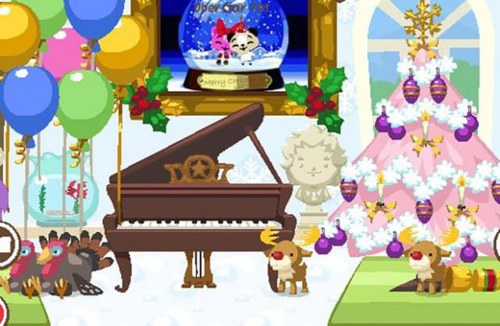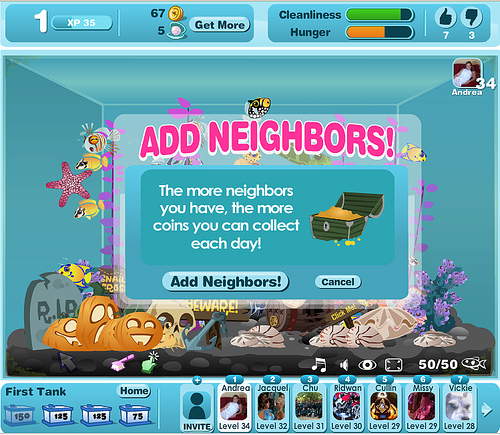Tony Ventrice谈社交游戏设计的三大目标
游戏邦注:本文作者是Tony Ventrice,他在2009年12月撰写此文,解释了社交游戏的基本定义及相关设计原则。
其实社交游戏正在繁荣发展这种说法仍然过于保守,Facebook和MySpace等社交网站上的游戏问世还不到几年,其用户数量就已呈现爆炸式的增长。
投资者当然也注意到了这种情况,即便是在极端萧条时期,新兴社交游戏公司仍旧接二连三地出现。竞争必然衍生冲突,社交游戏也不例外。这一领域早已深陷克隆山寨和法律诉讼的泥潭,各个公司一心惦记竞争对手的动态,却忘了为自己规划更广阔的未来。
在一窝蜂地涌向这个新兴领域、盲目投入大笔金钱、资源以及频繁地应付法律争端之前,我们是否更应该先仔细想想:究竟何为社交游戏?如果事先已思考过这一严肃的问题,我们的思路可能就会豁然开朗,找到更多发展机遇,缓解一些竞争压力。
社交游戏的定义是什么?
“社交”这一术语的描述也许还不够准确。《Pong》具有社交性,《Super Mario Kart》和其他上千款支持多人模式的游戏也同样具有社交属性。如果“社交”并不代表“多人模式”,那么它究竟有何深意呢?
大型持续性游戏其实也不是什么新鲜事物,哪里有互联网,哪里就会有像MUD(游戏邦注:Multiple User Domain,多用户虚拟空间游戏)之类的游戏。随着互联网技术的发展,这些多人模式游戏也呈现出了许多新特点,像《第二人生》(Second Life)和《魔兽世界》(World of Warcraft)等游戏也都带有无可争议的社交性,如果说社交游戏早已问世,那为什么近年来才出现“社交游戏”这种说法呢?这种游戏究竟有何不同?
就某些方面来说,这些游戏并没有什么不同,它们仍然像过去的游戏一样好玩而富有黏性。但在某些方面,它们的性质发生了根本的变化,Facebook等社交网站将游戏带人了一个全新的发展境界:在此之前,用户不得不费力地自己找游戏,如今却是游戏主动出击找上门来。社交游戏正是凭借这种新力量,创造了令人兴奋的发展潜力。
社交游戏的设计目标
以下是我简单罗列出的三个社交游戏设计目标,将在后文中详细拓展说明。 1.创建一个持久稳定的社区——促进玩家的彼此协作 除了让玩家留言,比较游戏积分,社交游戏的目标应该是创建一个社区。要实现这一点,就需要玩家之间的相互依赖;一个真正的虚拟社区需要这样一种游戏环境,即用户没有他人的帮助,就不可能顺利完成任务。
2.培养用户持续探索新事物的精神——促进用户的进步和自我表现 这一特点即玩家在游戏中不断探索,建立或者培养新事物,让他们感觉自己仿佛和游戏中的角色融为一体,共同进步,并对周围的游戏环境施加影响力。
3.以病毒式传播渠道扩大用户规模——让用户推荐好友参与游戏 Facebook等社交网站的广泛普及,为用户提供了既定的网络平台、较低的准入门槛,大大方便了社交游戏的病毒式传播。
那些善于利用用户与好友之间彼此信任、熟悉等优势的游戏,很有可能轻而易举地实现呈指数增长的用户规模。如果游戏找到了一个新玩家,并想继续扩大影响力,那它就需要留住现有玩家,并将其培养成游戏的忠实布道者。
病毒式传播方式
在社交网站上,病毒式传播有两种方式:直接手段和间接途径。
直接手段——好友邀请 由一名用户给另一名用户发送信息,直接邀请对方参与游戏,通常采用请求的方式(游戏邦注:如“加入我的游戏”这类请求信息)。但由于它是一种不请自来的信息,所以通常被视为具有冒犯性,但如果对方也有强烈的参与欲望或者对情况一无所知,这种功能就会很管用。
Facebook之前的热门游戏《Farm Town》是以赠送礼物的方式邀请用户参与游戏。用户可以将免费礼物赠送给好友,但不能自送礼物。在这种互赠礼物的前提下,大家就会在你帮我,我帮你中礼尚往来。
互赠礼物的机制是一种理想的直接传播方式,因为它同时满足了用户的自私心理(“如果我给朋友礼物,也许他就会加入我的游戏,也回送礼物给我”)和利他主义的精神(“如果我送礼物给朋友,我保证他一定喜欢”)。所以送礼者并不会觉得自己在发送垃圾信息,而受礼者也会认为自己得到了有价值的东西。
间接途径——信息墙传播 社交网络的另一大优势在于它的传播效能,Facebook在这方面的表现形式是信息墙报。信息墙上的内容是用户个人的一种公开声明,几乎任一款游戏中的活动都可以做成一个墙报,如果用来号召大家采取行动,则可成为游戏病毒式传播的一个有效渠道。
在《FarmVille》中,常见而有效的墙报就像一只“走丢的动物”,它向其他用户宣布:你发现了一只走丢的动物,它想有个家,有没有人愿意领养它?在游戏环境中,这一功能就像一份礼物,唯一不同的是它们的定位,走丢的动物寻找的是更广泛的用户群体,而礼物则是直接赠送给特定的用户。
创建持久的游戏社区
这里有两个关键词:“持久”和“社区”。“持久”形容从不间断,不需要分段玩游戏的状态;“社区”指这一游戏体验建立在互帮互助和团队合作上。
持久
即使某些玩家不在场,游戏世界也仍会照常运转。一般玩家都知道,自己离开了一段时间就意味着失去大量的发展机会,这一点也正是游戏能够吸引玩家隔段时间重新返回的原因所在。 最基本的持久性形式可以通过定时器实现(游戏邦注:例如在《Mob Wars》中,玩家在承担更多“任务”之前,必须等元气恢复才行),但在一个成熟的游戏社区,其他用户的行为会推动游戏进程,催生出更多发展机会。
社区
社区是建立在相互依赖和团队合作的基础上,这也正是《魔兽世界》等MMO游戏在这个方面略胜一筹的原因。《魔兽世界》要求玩家各有所长,例如,盗贼最适合在幕后行动,在获得最大优势时才发起攻击,而更为强悍的战士则可痛击怪物,具有超强的生命力,能够承受非常极大的伤害。这两者组队总比单兵作战更有效率。
当玩家继续推动游戏进程时,就会发现游戏任务越来越有挑战性,他们要学会共同协作才能获胜,这也正是社交游戏可以长时间保证更多用户留存率的最主要机制。
用户的个人专长不但让玩家与紧紧相连,而且还为用户搭起了互动的桥梁,如果玩家被他人所依赖,那么他们就会觉得自己是被需要的,自己的存在很有价值。
如果一款游戏已经自我创建了一个持久的社区,那么退出游戏就不再只是个人决定,用户得先考虑整个玩家群体对他抱有什么期望。如果某个用户离开了,其他玩家都会想念这个队友,在人际关系日益疏远的现代社会,这可是一种不容忽视的情感。
持续探索新事物的精神
探索发现可以保持一项活动的新鲜性和趣味性。在社交游戏中,玩家永远不会觉得自己已经打败或完成了整个游戏任务,而是总会发现自己还有未竟的事业,还有未经历的体验。
收集东西——利用人们爱收集事物的天性
收集东西是人类的一种强大本能——从麦当劳的快乐套餐玩具到两美元钞票,甚至是我们在沙滩上发现的石头,都让我们有收集的冲动。
在《Animal Crossing 》或者《Pet Society》这类游戏中,它们的收集模式最受关注,其提供的收集道具多数充满了绘画元素,可以用来装饰玩家在游戏中的房子。
有些时候,这些东西是人人所知并梦寐以求的(例如,“我正在存钱买下那个娱乐中心”),有些时候这些东西可能是随机出现的,没人知道它是什么(例如,“收集的贝壳左边多了两个槽,它们是什么贝壳,有什么作用呢?”)。不论是哪种方式,它都为用户设置了“做事”的直接目标、成就更大梦想的长远目标,同时也成了用户与好友比较游戏成就的一种衡量标准。
为了不让游戏过早结束,这种收集发现模式一般都会要求玩家无休无止地找到更多东西;玩家很容易获取早期需要收集的东西,并因此尝到甜头希望找到更多东西,不过接下来的搜集任务就更有难度了,又有新目标形成了,玩家实现目标的过程永无止尽。
用户自我表现——扩大用户游戏体验 另一种发现模式主要建立在用户创造性的基础上,前提是向用户提供基本的工具,让他们能够自己动手表现。当用户能够表现自我时,游戏社区总是会不断生成新的内容,让用户去查看和体验。这种发现模式来自于两个方面:见证其他玩家创造的东西,以及找到自己的灵感。
在《YoVille》、《Pet Society》、《The Sims》等游戏中,玩家常因简单的房屋装饰感到乏味,从而为自己设定富有创造性的目标,如把一个房间弄得像森林或者太空站,这方面的典型是《(fluff)Friends》这款游戏。
《(fluff)Friends》表面上看和《Pet Society》很相似,也是要求用户逐渐收集小道具和成套装备,但它的终极目标却很明确,就是创造(fluff)艺术。用户的任务并非为了收集而收集,而是通过收集东西进行自我表现。在游戏中的艺术馆内,用户可以观看所有玩家的杰作,这些作品个个都有标签,并且分类展示出来。
游戏中的艺术创作只是一个普通的例子,但社交游戏的收集机制还有其他多种可能。PlayStaton网络游戏《LittleBigPlanet》不但支持用户通过创造新事物进行自我表现,而且还鼓励他们分享完整的互动游戏体验。
社交游戏举例分析
接下来我会列举几款Facebook游戏进行分析,并根据其用户体验、受欢迎潜力进行打分,评分范围是为1-5分。市场营销、营收渠道等商业运营方面的内容,不作为评分参照标准。
《FarmVille》
病毒式传播 5分:它的邀请方式是最不具冒犯性的“送礼”机制,其墙报信息也非常具有竞争性(游戏邦注:如“我升级了”等内容)和同情性(“走丢的动物”特性)。它通过可爱的五彩插图和明确的现实需求结合在一起,这些智慧的操作让《FarmVille》通过病毒式传播迅速窜红,在非游戏用户中尤其具有杀伤力。
持久的社区 3分:这款游戏的持久性在于,它鼓励玩家定期回去查看并收割庄稼,但这种社交体验很力量单薄,无助于加强基本的游戏设置。
它的社交互动主要来自用户与朋友交换礼物,但当每个用户都有了硕果累累的李树或者鹅形灌木丛时,这种方法就变得没有意义了,要不然就是“帮助解决朋友农场的问题”——用户名义上支付了一定的现金,但这事很快就变得和他们毫无瓜葛。
新功能探索 2分:《FarmVille》经常为用户提供新的庄稼品种,但这些内容对用户来说只有养眼的功效,并没有多大实际意义。新庄稼除了高投入,高产出,并没有表现出任何不同功能,或者提供任何形式的策略优势。
有些自我表现功能仅限于高级用户,主要表现形式是装饰性的小道具,以及创造“干草堆艺术”的机会——使用五彩的干草堆创造高像数艺术品图像。
总分:10分(病毒式传播5分,用户留存方式5分)
《Pet Society》
病毒式传播 2分:它的病毒式传播方式比较微妙,会不定期地弹出提示信息,让用户邀请好友参与游戏,而其他游戏的病毒式传播却都是由用户主动发起的。改变宠物的“状态”会生成一个墙报提示信息。“贴纸包裹”是可以送给朋友的礼物,但对新玩家来说这更像是个次级的选择。
这款游戏的病毒式传播方式最值得一提的地方在于,它提供了一个画面极其干净、视觉上具有吸引力的游戏,为用户创造了大量自我表现的机会;实际上,它正努力使成为一款让玩家愿意和好友分享,并怂恿他们将它推荐给其他好友的游戏。
持久的社区 2分:《Pet Socielty》的内容其实没多少持久性——如果你离开了一小会儿,你的宠物将会又饿又脏,除此之外什么都没有变。如果你想尽可能多赚钱,就必须一天回来一次。玩家之间的互动也很少——即使是在游戏中建立关系,目的也无非是更好地赚更多钱。
新功能探索 4分:这款游戏有大量的个性化选择,从衣服、家具、植物到进口鱼等等,应用尽有。它的艺术品丰富,独具风格,供应也很稳定,甚至可以让没有艺术天分的玩家也能发挥无限创意。大家未见过的鱼和植物等稀罕物,只能通过捕捉或种植获得,但这种方式更容易为用户创造惊喜。但如果用户想得到什么,首先得有钱币。他们通过不厌其烦地拜访朋友或者举办比赛,可以挣到一些零花钱。
总分:8分(病毒式传播 2分,用户留存方式:6分)
《开心水族馆》(Happy Aquarium)
病毒式传播 5分:游戏中有“发送食物”、“免费礼物”、“邀请朋友”以及类似“拯救濒临灭绝动物”的墙报。它的视觉艺术效果可能并不那么让人印象深刻,但病毒式传播方式却够直接够明白,很容易让人理解。
持久的社区:2分: 藻类生长和病鱼会让玩家心里惦记并定期返回游戏,但这款游戏还是没有跳出“靠拜访朋友赚钱”这个模式的窠臼。
新功能探索 1分: 可能因为是新型游戏,所以开发商预留了许多可扩充内容的空间,但目前水族馆并没有什么东西可以长期留住玩家。一般的水族馆装饰可以放在鱼缸的底部,并能够通过购买而得,但更高级的鱼缸看起来跟普遍鱼缸并没有多大差别。
总分:8(病毒式传播 5分,用户留存方式 3分) 另外需要指出的是,社交游戏的定义与其设计并非直接相关——它们的设计会随着时间的推移而改变。当这一领域的市场饱和时,社交游戏不但将增加更多鼓励玩家探索新功能的内容,而且还会将烦人的病毒式传播策略变成一种更令人悦愉的用户体验。所以,上文所述的内容只是针对社交游戏当前状态的评价,并不能描述它的过去情况或预测未来走向。
总结
很少有一款社交游戏能同时将上述三个功能(病毒式传播、持久稳定的社区、新功能探索)发挥到极致,这并不是因为三者互相排斥,而是因为它们的存在有赖于不同游戏机制的发展。尽心尽责的设计师,有可能从《Farm Town》和《魔兽世界》中汲取灵感,推动社交游戏的前进。
我认为用户间的互助协作尤其具有许多可挖掘的潜力。不论是《Farm Town》中的互赠礼物,还是《魔兽世界》中令人生畏的互动战斗,都存在大量未被开发的游戏设计空间。 我们的日常生活都充满不同程度的依赖,社交游戏领域居然也奉行如此相似的观点,这不能不令人感到惊讶。这些年来,我们已见到游戏鼓励用户探索新功能,也看到许多游戏在社交网络上以病毒式传播方式虏获大量用户,但游戏设置中最强大的部分却在于互助协作以及真正持久的社区。
社交游戏的未来发展还有无限可能,如果我们能集中关注大局,少重视那些外表克隆得相当完美的山寨产品,相信不久后我们终会看到社交游戏的真正进步。(本文为游戏邦/gamerboom.com编译,转载请注明来源:游戏邦)
Building the Foundation of a Social Future
To say that social games are booming is an understatement. After having been in existence for only a scant few years, games on social networks like Facebook and MySpace are gaining users explosively. There are now over 200 million monthly users playing the top 10 Facebook games alone — up by 50 million from August to September.
Investors have certainly taken notice and, even in the depths of a recession, startups have been popping up left and right. With competition comes conflict and social gaming has been no exception — already the space is a mire of me-too clones and lawsuits, with companies so busy looking over the shoulders of their neighbors that they’ve lost sight of the bigger picture.
Rather than dashing headlong into this new space, throwing money, resources and litigation blithely and blindly, it may behoove us to pause for a moment and consider: just what is a social game? A little critical thought up front might open more opportunities and alleviate some of the pressure to borrow from the competition.
So, What is(n’t) a Social Game?
The term “social” is perhaps not very descriptive. Pong was social and so was Super Mario Kart and a thousand other games played by more than one player at a time. So if “social” doesn’t mean “multiplayer”, what does it mean? Does it imply something larger and more persistent?
Well, large persistent games aren’t exactly very new either; as long as there has been an internet, there have been games like MUDs. As the internet evolved, these multiuser games evolved right along with it, giving us games like Second Life and World of Warcraft. These games are undeniably social, so why all the recent talk? If social games are nothing new, what’s changed?
In some ways, nothing’s changed — games are still engaging and fun for all the same reasons they’ve always been — but in other ways, everything has changed. Social networks like Facebook are bringing games into a completely new context: where, up until now, the user was compelled to find the game, now the game is able to find the user. With this new power, comes exciting potential, game-changing potential.
The Objectives of Social Game Design
Social games can be defined by three implicit objectives, which I will first list as mandates to the designer, then cover in more detail.
1. Build a persistent society — promote cooperation
Beyond just allowing players to leave messages and compare scores, the goal of a social game should be to build a society. To achieve this, interdependence needs to exist; a true virtual society will only arise from a game environment where players can’t fully succeed without the help of others.
2. Maintain a consistent sense of discovery — promote user advancement and expression.
This feature describes a game environment where the user is continually discovering, building or nurturing new things into existence. Players should feel as if they are evolving both their in-game persona as well as influencing the game world around them.
3. Spread the game virally — promote recruiting friends
This facet of social game design is made possible by the widespread adoption of online social networks like Facebook. Social networks provide a pre-existing web of low-barrier-of-entry connections.
Games that tap into the trust and familiarity existing between friends have the opportunity to spread effortlessly on an exponential scale. Once a game finds a new user, however, if it is going to continue spreading, it needs to retain and convert that user into a new evangelist.
Spread the Game Virally
On a social network, virality takes two forms: Direct and Indirect.
Direct — the request
A direct invitation to join the game, given from one user to another, often takes the form of a request (i.e. “come join me in this game”). Because of their unsolicited nature, direct requests are often perceived as intrusive and it helps if there is both a strong motivation and an innocent context, to facilitate the process as much as possible.
The Facebook hit Farm Town hides its requests under the guise of giving gifts. You are allowed to give gifts to your friends and gifts are free to give, but you can’t give them to yourself. Thus, gifts inspire a “you scratch my back, I’ll scratch yours” dynamic.
Gift-giving interactions exemplify ideal direct viral contact because they simultaneously fulfill selfish motivations (“if I give my friend a gift, maybe he will join the game and give me one back”) and maintain a sense of altruism (“I’m giving my friend a gift, I bet she’ll love it”) so senders feel less like they are spamming and receivers feel more like they are receiving something of value.
Indirect — the broadcast
The other major advantage social networks is the ability to broadcast. In Facebook this is the wall post. A wall post is nothing more than a public declaration made by an app on behalf of an individual. Almost any event in-game can be used to generate a wall post, but, if it is positioned as a call to action, it can serve as a means of reaching out to friends and spreading the game virally.
In FarmVille, a common and effective wall post is the “lost animal”, a post which declares that you have found a lost animal in need of a home, and won’t someone please adopt it? In game terms, this functions just like a gift –the only difference is the positioning: lost animals are served to a larger yet less direct audience than gifts.
Build a Persistent Society
There are two key words here: persistent and society. “Persistent” describes a game world that does not stop and start with each play session. “Society” implies a game experience founded in cooperation and teamwork.
Persistent
A persistent game “lives” even when the player is not present. A player knows that time spent away means potential missed opportunities and this can be a powerful hook that draws him back into the game at regular intervals.
In its most basic form, persistence can be contrived with timers (such as in Mob Wars, where you must wait for your energy to recharge before undertaking more “jobs”) but in a full-fledged society, opportunities should be arising organically from the actions of other users.
Society
A society is built on interdependence and teamwork and this is where MMOs like World of Warcraft excel. WoW forces players to specialize; for example, a rogue is good at sneaking in for a devastating attack while a tougher warrior keeps a monster busy and absorbs damage. Both players are more effective as a team than individually.
As players progress, and game objectives become more challenging, they need to learn to work together to succeed. It’s this dynamic of teamwork that has retained more users for more hours than the majority of games.
Not only does specialization create a bond between player and game, but it creates a bond between players. A player that is depended upon by others feels needed.
Once a game establishes a persistent society of its own (and is no longer simply riding on a surrogate, like Facebook), abandoning the game becomes more than a personal decision; there are now the expectations of the group to consider. A player that leaves will be missed, and this is a motivator not to be overlooked in our increasingly disconnected modern lives.
Maintain a Consistent Sense of Discovery
Discovery is what keeps an activity fresh and interesting. A player should never be allowed to feel as if he has “beaten” or “completed” a social game. This means there always needs to be something else to acquire or experience.
Acquisition — the instinct to collect
Collecting stuff is a powerful instinct in humans — from McDonalds happy meal toys to two-dollar bills, or even just stones we find at the beach, we humans are compelled to collect.
In a game like Animal Crossing or Pet Society there is a heavy focus on this collector model of discovery, with the collected items often being graphical elements that can be used to decorate your house.
Sometimes this stuff is known and aspirational (“I’m saving up to buy that entertainment center”) and other times its unknown and random (“the seashell collection has two more slots left in it; I wonder what kind of shells they could be?”) Either way, it provides the user a straightforward goal of something to do, a longer-term sense of building something larger, as well as a gauge of status when comparing success with friends.
In order to suspend reaching an ending, the collector model of discovery typically follows an exponential effort curve on the route to getting more stuff; early additions to your collection are easily obtained and give you a taste for more, but further items require increasingly more effort and new goals are always cropping up just as previous goals are reached.
User Expression — opening up the experience
The other model for discovery relies on user creativity. The premise is basically to give the user a palette of tools that enable self-expression. When users are enabled to express themselves, there will always be something else to see and experience because the community will be constantly creating new content. The discovery comes from two sides: witnessing what other players have created, and discovering you own inner muse.
In games like YoVille, Pet Society or The Sims, players often grow bored with simple house decorating and set creative objectives for themselves, such as making a room look like a jungle or the inside of a space station. This phenomenon was made the objective of the game (fluff)Friends.
(fluff)Friends is ostensibly similar to Pet Society, with the user collecting props and outfits over time, but the end goal is explicitly the creation of (fluff)Art. The appeal of the game becomes not so much to collect for collection’s sake, but to collect as a means toward self-expression. The resultant scenes of user art are captioned, categorized, and publically browsable via in-game galleries.
The creation of art is just one common example, yet the possibilities are much broader. The PlayStation network game LittleBigPlanet harnesses user expression to allow the creation and sharing fully interactive gameplay experiences.
A Look at the Industry
I’ll rate a few of the top Facebook games, in each category, on a scale of 1 to 5. The ratings will be focused on user experience and potential for popularity. Business considerations, such as marketing and monetization, are arguably independent from the objective of strong social game design and will omitted here.
FarmVille
Virality: 5. Invites come in the minimally invasive form of “gifts”. Wall posts are both competitive (“I leveled up”, etc) and “lost animals” which catch attention by playing to human compassion. Combine this with cute colorful artwork and a clear physical metaphor and it’s no wonder FarmVille spread so well, particularly in non-gamer demographics.
Persistent Society: 3. The game is persistent in that players are encouraged to regularly check back in to harvest crops, but the social experience is weak and does little to improve the basic gameplay.
Social interaction predominantly comes in the form of trading gifts with friends, which pays off handsomely until it gets old (or everyone has had their fill of plum trees and goose topiaries), and “helping out around your friend’s farm” — which pays a cash sum so nominal, it quickly becomes irrelevant.
Maintaining Discovery: 2. FarmVille makes a steady drip of new crops available to the player, but these seem only to offer an aesthetic incentive. New crops don’t really behave any differently or provide any form of tactical advantage beyond higher cost and higher payouts.
Some amount of user expression is available to higher-level users in the form of decorative props and the opportunity to create “hay bale art” — pixel art images created using colored bales of hay.
Total – 10 (5 viral, 5 retention)
Pet Society
Virality: 2. Pet Society is subtly viral. It occasionally pops up a prompt to invite your friends, but otherwise all virality is user initiated. Changing your pet’s “status” triggers a wall post prompt. “Sticker Packs” are gifts you can send to your friends, but they seem like a secondary consideration to new players.
The most that can be said of Pet Society’s viral strategy is that it provides an immaculately clean, visually attractive game with ample opportunity for self-expression; effectively, it is striving to be a game that players want to share with their friends, and leaves the task of spreading it in their hands.
Persistent Society: 2. There is very little that is persistent about Pet Society — if you’re away for even a small amount of time, your pet will be hungry and dirty, but otherwise nothing really changes while you’re away. If you want to maximize earning money, you’ll have to return once a day. There is also very little interaction between players — an attempt is made to create a sense of relationships but this is really nothing more than a mechanic to grind out coins.
Maintaining Discovery: 4. Pet Society has an immense wealth of personalization options, from clothes, to furniture, to plants, wallpapers, and exotic fish. The art is lush, stylized and consistent, giving even artistically inept users an infinite space of creative possibility. Unknown items like fish and plants must be caught or grown, instilling an element of surprise. Yet, in order to acquire anything, the user first needs coins. Coins are earned through the tedious chores of visiting friends’ houses and running races, both of which seem to pay out pocket change.
Total: 8 (2 viral, 6 retention)
Happy Aquarium
Virality: 5. There are “Send Food”, “Free Gifts”, and “Invite Friends” invites as well as what may now be an industry-standard “Rescue the Endangered Animal” wall posts. The art may not be all that impressive, but the aquarium metaphor is about as direct and accessible as you can get.
Persistent Society: 2. The danger of algae growth and sick fish keeps players coming back regularly, but Happy Aquarium does nothing to innovate on the basic
“visit friends to earn money” mechanic.
Maintaining Discovery: 1. It may be that this game is new and the developers plan to expand the selection of available items for your aquarium, but currently there is not much to keep a player engaged long-term. Typical aquarium decorations can be placed on the bottom of your tanks and increasingly more expensive fish may be bought, but very little has been done to prevent high-level fish tanks from all looking the same.
Total: 8 (5 viral, 3 retention)
One additional observation worth making is that social games are not tied to their designs — they can conceivably change over time. Just as content can be added to expand the potential for discovery, a game geared towards virality can sacrifice annoying viral tactics in favor of a more satisfying user experience, as it reaches market saturation. Considering this, evaluating an app at one moment in time does not necessarily describe its past or predict its future.
The Future
It’s a rare social game where all three of the above features (spread the game virally, build a persistent society, and maintain consistent discovery) are utilized to good effect. This is not because the three are mutually exclusive but simply because they are served by distinct game mechanics that have evolved separately. It will take conscientious designers, willing to take cues from predecessors as diverse as Farm Town and WoW, to evolve the medium to the next level.
In particular, I believe that the context of cooperation still has much room for exploration. A vast untapped gamespace exists between the insultingly simplistic gift-giving interaction of Farm Town and the dauntingly choreographed combat interaction of WoW.
Our daily lives are so rich with layers of social dependencies that it’s a wonder the social gaming space is determined to cannibalize the same narrow range of ideas. For years now, we’ve seen games that create discovery and there is now a wealth of games spreading virally across social networks, but the real key to compelling gameplay is in cooperation and the foundation of truly persistent societies.
Social gaming has tremendous potential and, if we can look past the picture-perfect clones long enough to see the big picture, it may not be long before the tables turn and games begin evolving the way we think about social networks, instead of the other way around. (source:gamasutra)











































 闽公网安备35020302001549号
闽公网安备35020302001549号